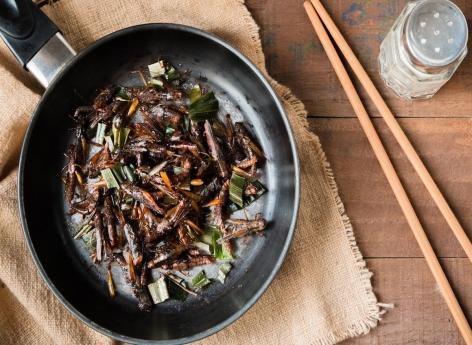primary
- Eating insects is called entomophagy.
- 80% of the world’s population already consumes insects.
- The insect harvest cycle is approximately 45 days, compared to 36 months for conventional farm animals.
Ten billion people will live on Earth in 2050. Faced with depleting resources, with sometimes difficulty accessing water and agricultural land, how will we be able to feed the entire population? Insects are one solution. “I’m not saying that insects will replace our farm animals, but it is an alternative that seems more sustainable than what we are doing now.”says Jacek Jaczynski, professor of food sciences at West Virginia University. It reminds us that insects have a short lifespan, that they multiply quickly and have simple habitat and food needs. With his team, he found a way to isolate proteins from insects, to make them more easily consumed. Their work is published in the specialized journal LWT.
How do you isolate proteins?
The patented Protein Isolate Technology allows purification and concentration of proteins from different sources. “For example, milk contains water, fats, carbohydrates, vitamins, minerals and various proteins such as casein and whey., details by Jacek Jaczynski. Whey protein can be isolate by various isolates, which remove water, fat, carbohydrates, etc. This process results in whey protein isolate or purified and concentrated protein. “ This isolate is used regularly today to develop foods rich in protein. “For insects, our goal is to selectively extract these nutrients, such as proteins and lipids.“, adds the researcher. To achieve this, they use a technique called solubility precipitation at pH, which allows obtaining good quality isolates.”Precipitation is the opposite of dissolving, Indicates. When a protein dissolves in a solution, it visually disappears from that solution, like sugar or salt, while when the protein precipitates, it visually reappears.”
Why isolate protein from insects?
And to make the consumption of insects more attractive, the researchers suggest turning the insect into a powder, as is already the case for grains, after reducing it to flour. Today, insect-based diets are widely used around the world, but they are struggling to gain traction in Western cultures. “It is a minority that does not eat insects.”, estime Jacek Jaczynski. “We need to find a way to extract and isolate the highest quality nutrients and develop prototypes that will appeal to our taste buds well.. “In all, more than 2,000 species of insects have been identified as safe for human consumption.

“Subtly charming problem solver. Extreme tv enthusiast. Web scholar. Evil beer expert. Music nerd. Food junkie.”


